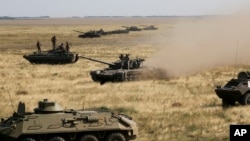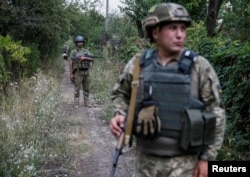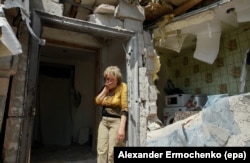What is President Vladimir Putin planning for Ukraine? Kyiv officials argue Russia’s leader is accumulating pretexts to justify a major assault with the aim of securing a land route through Ukraine’s southeast regions to Crimea, the Black Sea peninsula Moscow annexed weeks after the 2014 ouster of Putin’s ally Viktor Yanukovych.
They see the escalation of fighting in the country’s mainly Russian-speaking eastern region of Donbas, where for more than two years pro-Moscow militants and Russian forces have been locked in a so-called ‘frozen conflict’ with the Ukrainian military, as a prelude for an offensive.
The massing of Russian troops and hardware, including S-400 Triumph missiles, in Crimea and last week’s claims by Moscow that Ukraine infiltrated saboteurs into the peninsula with the plans to commit “acts of terrorism” — something Kyiv vehemently denies — are viewed in Kyiv as ominous signs. Ukraine’s military intelligence officials say they expect more sabotage claims by the Kremlin, insisting “the enemy is planning large-scale provocative actions” in a bid to discredit Ukraine in the eyes of the West.
Their thinking is that Moscow is planning an offensive to start just before Russian parliamentary polls scheduled for September 18. Russian officials, who say the provocation is coming from Ukraine — not the other way round, deny this.
“Putin needs a nice small, victorious war,” argued Alexey Arestovych, a former Ukrainian intelligence officer and now independent military analyst.
If there is a major offensive, “the Russians will want to take Mariupol,” he suspects, part of a ground campaign to secure a land corridor for Crimea. That would avoid the need for Russia to spend billions building a bridge spanning the Kerch Strait as well as energy pipelines linking the peninsula to the Russian mainland.
Arestovych, who is familiar with the thinking of top Ukrainian military planners, said one scenario Kyiv army strategists fear would see Russian forces pushing out from Crimea into Ukraine’s Kherson and Zaporizhya oblasts, and driving as far north as the town of Enerhodar before swinging east to Rozivka and then on to the port city of Mariupol.
Some members of the monitoring mission of the Organization for Security and Cooperation in Europe’s (OSCE) based in Mariupol already have “grab bags” of their possessions ready for hasty evacuation.
Last week, Oleksandr Motuzyanyk, a security spokesman for Ukraine's presidential administration, told VOA that Russian drone activity had increased dramatically, with some surveillance incursions going deep into Ukrainian territory - including in the airspace above Kherson and Zaporizhya oblasts adjacent to Crimea.
In their contingency planning, Ukrainian military strategists say the heights just south of Kramatorsk and north of Horlivka in the Donbas would likely be another major Russian military objective. Seizing the heights would give Russian-backed forces a strategic vantage point for shelling Ukrainian forces besieging the separatist-held city of Donetsk. The heights also offer command of two important crossroads.
There will be diversions and movements, Ukrainian strategists think. “If they start with an offensive from Crimea we would be able to hold them back,” claims Arestovych. He says Ukraine’s military is in much better shape than it was last year, thanks to training by Western military advisers from the US, Canada and some other NATO countries. The Russian military and pro-Moscow separatists “would start first in the east to try to divert us,” says Arestovych.
In the Donbas the sides are more or less evenly matched. Ukraine has about 100,000 soldiers now, say officials, deployed along the 500-kilometer contact line in eastern Ukraine, where the warring sides have traded fire for months despite the 2015 Minsk 2 cease-fire agreement brokered by France and Germany.
Ukraine military officials estimate there are 45,000 Russian-backed forces consisting of local recruits, former Russian servicemen and current Russian regulars on Ukrainian territory in the east with another 45,000 regular troops stationed just across the international border in the Russian Federation.
In the south the match-up may not be so even. Ukraine has four brigades — about 10,000 men — stationed in the Kherson and Zaporizhya oblasts, although they could be reinforced by another two brigades held in reserve. Since annexing Crimea in 2014, Russia has been building up its forces and military hardware, say Western and Ukrainian officials, on the Black Sea peninsula and there could be as many as 45,000 regulars there now.
It is the movement of soldiers and equipment to the north of Crimea that has Kyiv especially unnerved: the frontier between Crimea and Ukraine has been relatively quiet since the annexation with no cross-border clashes.
Anton Lavrov, an independent military analyst and author of a book on the 2008 Russian-Georgian war, argues the Kremlin is not on the brink of launching a major offensive. ”The situation in the Donbas will not be aggravated by the initiative of Moscow because of the lack of readiness of the Russian military to escalate the situation,” he said. He says no field camps have been established by Russian forces along the border with the Donbas, which he would expect to see if a campaign is being planned.
Col. Oleksandr Motuzyanyk, a security spokesman for Ukraine's presidential administration, agrees that it is difficult to predict what Moscow might be planning. “When there are clashes, we respond,” he says. But the OSCE has blamed both sides for cease-fire violations. Motuzyanyk suspects Russia is testing and probing, trying to fathom what Western political reaction would be in the event of an offensive and also what Ukraine’s military response would be.
He says Ukrainian forces in the Donbas are reporting new portable electronic jamming systems being used by Russian-backed forces in the east and they have observed an influx of man-portable, short-range guided anti-tank missiles known as Bumbars and nicknamed Bumblebees.
If a major offensive isn’t in the offing, what is Moscow planning? Some Kyiv officials think the aim might instead be to pressure the West to lift some of the economic sanctions imposed on Russia after the annexation of the Crimea.
A restoration of normal trade relations with the West would ease the perilous state of Russia’s economy, which shrank last year by four percent thanks in part to the plunge in the price of oil, and is on course, according to the World Bank, to diminish by at least another two percent this year.
In this scenario either Russia trades the easing of sanctions for staying its hand militarily. Or it succeeds in discrediting Ukraine in the eyes of the West with claims of sabotage missions like the incursions into Crimea the Kremlin alleges were mounted by Ukrainian intelligence last week.










